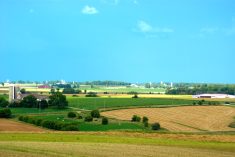Glacier FarmMedia – It’s a nice time to be carrying debt — if your business is flourishing.
Not only are interest rates low, but lenders are looking for borrowers who can pay their bills. That puts farmers in the driver’s seat.
Why it matters: Reworking debt when interest rates are low can reduce borrowing costs over time.
“I want you to push your banker. If you’re not working with a banker who understands what’s going on, find a new one,” said Tommy Grisafi, an adviser with Advance Trading, in a session on marketing grain during a pandemic.
Read Also

How stories promote farm safety
Speakers at CASA online conference explain how personal stories can be more valuable than statistics in communicating importance of farm safety
“It’s a competitive world. You don’t have to just work with one bank. You don’t have to sell grain to just one elevator.… Make sure your banker’s educated. If not, look for another banker.”
Interest rates are at historic lows. Central bank rates and central bank monetary activism has ensured that low interest rates extend out from the overnight rates and trickle down to the commercial rates farmers face.
Not only are some central bank rates at zero or near zero, in some places they have fallen into negative rates, punishing savers.
That has forced investors to delve into bond and other debt markets they would otherwise avoid, which has pushed down their yields and fed into commercial lending rates.
“There’s never been a better time in history to get organized and term out debt,” said Grisafi.
“There’s some really neat things you can do with terming out some money. My fear is that right now rates are low,” so farmers won’t see the need to lock in anything.
That’s a phenomenon J.P. Gervais, Farm Credit Canada’s chief economist, has witnessed. Nearby rates are extremely low. Longer term rates are very low.
And central banks including the United States Federal Reserve and the Bank of Canada have said clearly that they intend to keep rates lower for longer.
“I can’t blame businesses that say just a few basis points (difference between short term and long term rates) make a difference when you’re talking about millions of dollars in loans,” said Gervais in an interview.
However, assuming long-term rates will stay low isn’t necessarily safe. And watching the Bank of Canada’s overnight rate, the main one discussed in news reports, won’t necessarily reveal an increase in long-term rates if the overnight doesn’t move.
“People don’t pay attention to the yield curve,” said Gervais, noting the way that the spread between longer duration bonds and short duration debt, and between government and commercial bonds, can diverge in certain circumstances.
“All these other rates — the bond markets and so forth — those are the drivers in terms of what farmers and farm operators face in the marketplace.”
Farm debt management has sometimes played a critical role in farmers’ survival or failure. Especially during the 1980s, when interest rates soared into double digits, farm crises occurred when crop sales couldn’t produce enough margin to cover debt payments. That’s not the situation today.
“The amount of pain that came out of the 1980s was from 18 per cent interest rates,” said Grisafi.
But that isn’t an excuse to not take advantage of today. Money borrowed today in short-term loans or at variable rates can be locked in for longer, reducing interest rate risk.
That was something Angie Setzer’s Citizens Grain took advantage of when the U.S. Federal Reserve began signalling it intended to start boosting rates.
“We knew our cost of money was going to increase exponentially,” said Setzer.
“We went through our broker and managed to… hedge our interest rate risk.”
Inflation seems a long way away right now, but with a firehose of government money spewing cash in most western economies, it could re-ignite if the pandemic and recession lessen and economic growth revives. The central banks of the U.S. and Canada have said they intend to stick with low rates longer than in past recoveries, so nearby rates could remain suppressed even if inflation appears.
But longer term debt could move first, and that’s something some farmers might miss if they’re not carefully following the full spectrum of debt.
“That’s what you (might) see, perhaps,” said Gervais.
“Long-term rates start to go up and people not noticing.”
If farmers are enjoying the prospect of low rates, but are hanging on to purchase land or other capital goods when prices fall, they will probably be disappointed.
“If you’re waiting for land costs to come down, equipment costs to come down, any of those things, a lower interest rate is not going to allow that to happen,” said Setzer.
This article was originally published at The Western Producer.












